The Microsoft Lumia 640 Review
by Brandon Chester on June 9, 2015 8:00 AM EST- Posted in
- Smartphones
- Microsoft
- Mobile
- Lumia
- windows phone 8
System Performance
Since the state of benchmarking on Windows Phone is not as mature as Android, I haven’t been able to compare the Lumia 640 to the competition in every aspect that I would like to. What I have been able to do is put it through our standard browser benchmarks, along with BaseMark OS II to look at individual component performance, and GFXBench to examine GPU performance.
While the absolute performance of Snapdragon 400 is well known, certain aspects of performance are heavily impacted by a device’s software. A good example is browser performance, which is a function of both SoC power and the speed of a device’s browser and Javascript engine. Two devices with the same SoC can have very different browser performance.
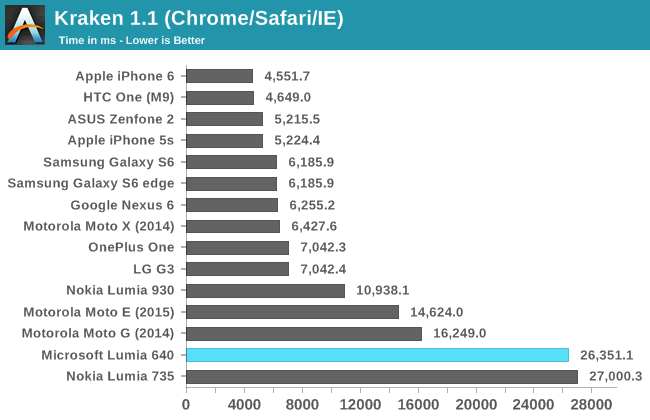
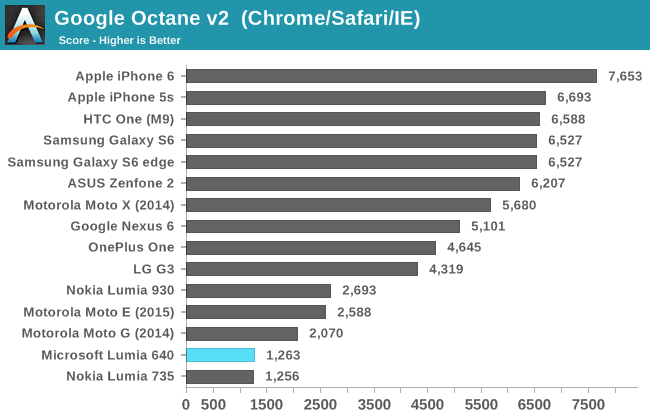
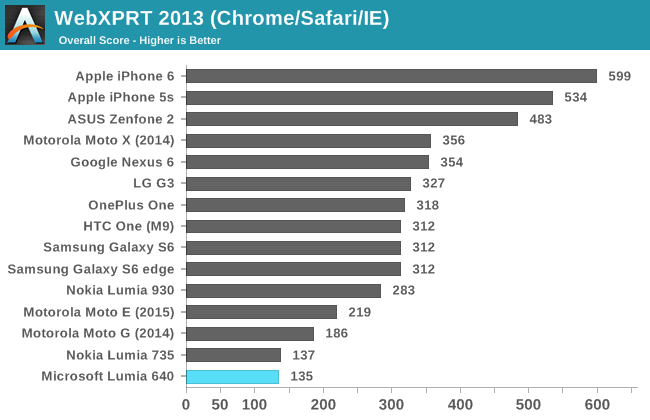
Unfortunately, it’s clear that Internet Explorer doesn’t measure up to Chrome and Safari when it comes to performance. While buyers may be pleased that their Lumia 640 performs as well as the more expensive Lumia 735, both of these phones occupy the lowest positions on every chart. There’s even a significant gap between them and other Snapdragon 400 devices running Android, such as Motorola’s Moto G.
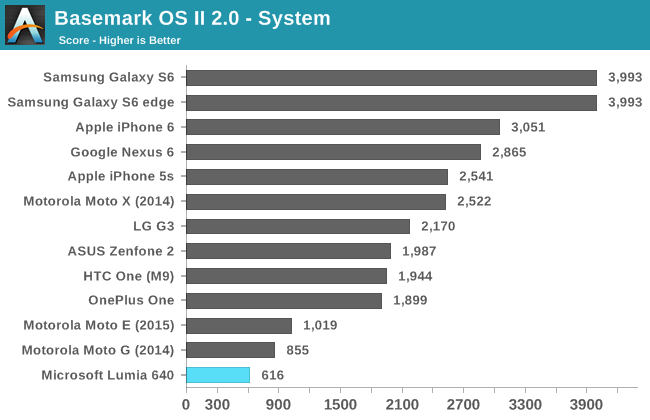
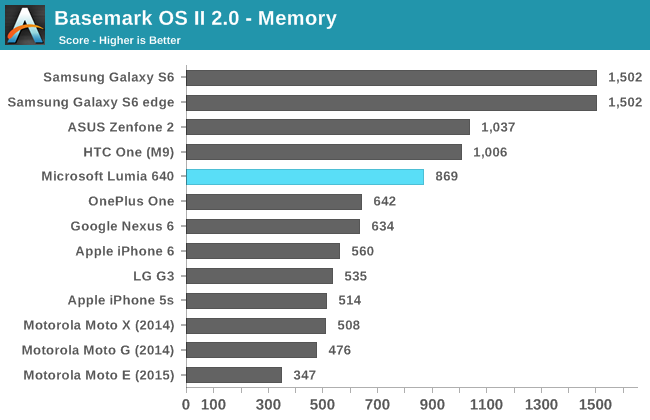


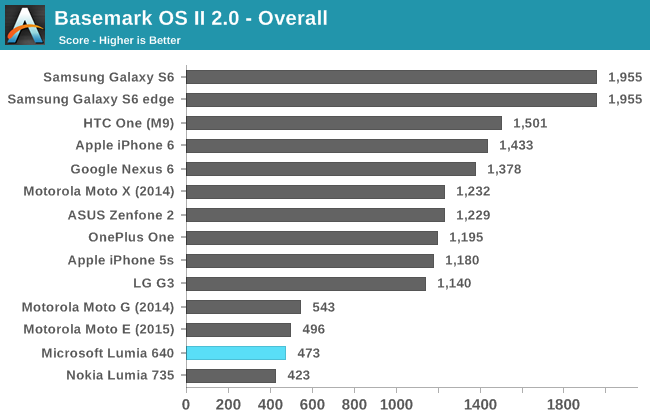
There's not much need to go into detail on the Lumia 640's performance in BaseMark OS II. With the exception of a fairly good result in the NAND memory test, the Lumia 640 achieves the lowest scores that we've seen in recent times.
Unfortunately, the Lumia 640 isn't shaping up to be a very quick device. It's consistently bested by Snapdragon 400 devices running Android, and in 2015 we're going to see Snapdragon 410 used as the SoC of choice in devices at this price bracket, which won't make the Lumia 640's position any better. Microsoft needs to iterate much quicker than they currently are. Their slow pace in adoption new hardware helped kill Windows Phone in the high end market, and it will do the same to the low end. I have some further words about performance on the Lumia 640 and Windows Phone in general, but those will have to wait until the software section of the review.
GPU Performance
The last area of performance to investigate is GPU performance. The performance of Adreno 305 has been thoroughly evaluated on Android, but differences in drivers and graphics APIs can improve or reduce performance across different operating systems.
Since Adreno 305 doesn’t support Direct3D feature level 10.0 and Shader Model 4.0 it’s unable to run the GFXBench 3.0 Manhattan test. This leaves us with only the T-Rex HD benchmark which isn’t very hard on high end devices, but still poses quite a challenge for weaker mobile GPUs.
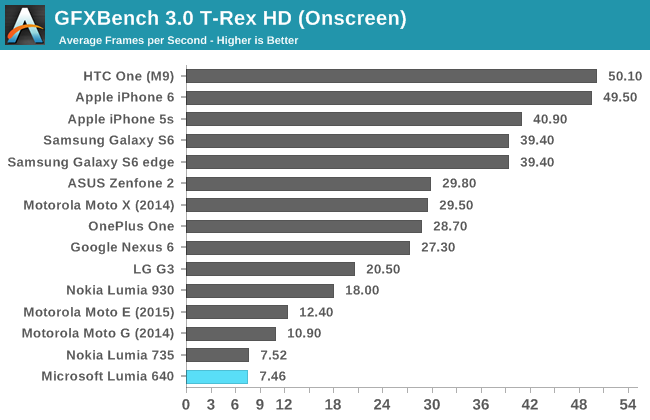
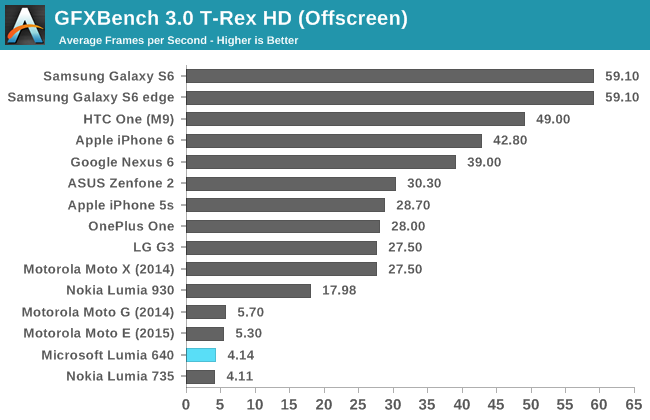
In both the on-screen and off-screen tests, the Lumia 640 lags behind the Moto G. While 1-2fps doesn’t seem like much, when your frame rate is in the low single digits it represents a significant difference in performance. Because of this, I decided to take a look at the performance in GFXBench’s driver overhead test to see what impact the GPU drivers and graphics API might have on performance.
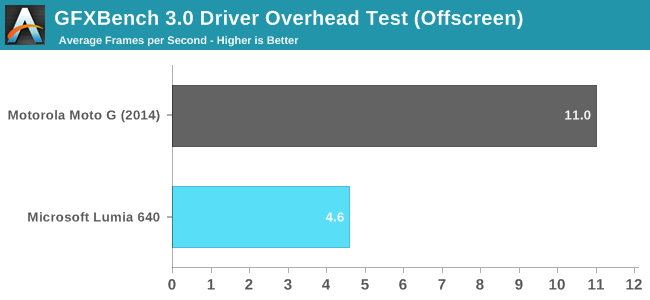
As suspected, there’s a very significant gap in performance when comparing the Lumia 640 to the Moto G. I can’t say whether this is due more to the differences between OpenGL and DirectX, or between the different Adreno drivers on Windows Phone and Android, but whatever the case may be the end result is a notable decrease in GPU performance on Windows Phone when compared to an Android device with the same SoC.
I’m not happy at all with the GPU performance that we see in low-end and even mid-range smartphones, and the Lumia 640 is no exception. There’s not much Microsoft can do here though, as moving to Snapdragon 410 with its Adreno 306 will not improve GPU performance at all. All I can really say is that users shouldn’t expect to be playing any 3D games on their Lumia 640, but simpler 2D games should run just fine.










130 Comments
View All Comments
gwydionjhr - Tuesday, June 9, 2015 - link
For the kind of user that is buying a $129 smartphone I think Microsoft has put it's priorities in the right place, a good camera and a screen that is readable in all conditions are things that any user will appreciate. I've helped dozens and dozens of normal users with all types of smartphones and I can only shake my head at the number of people paying $70mth to use a $700+ plus device that they only use for texting, email, FB and phone calls.cjs150 - Tuesday, June 9, 2015 - link
This is a cheap phone.It lasts most of a day between charges (not really good enough). It has a decent camera, decent display and presumably syncs really well with MS Outlook (if not what are MS doing!).
Is it slow - yes
Will it run the very latest apps - no.
Is it good enough for 90% of market aged more than 25 - yes. Ultimately on a tech website we forget that most people do not need most of the features. Checking emails, using maps/navigation and the ability to check social media is good enough
Very tempted - but for the battery life
MonkeyPaw - Tuesday, June 9, 2015 - link
And for all the bagging people are doing on MS for pushing out cheap phones, the strategy has really helped MS gain share outside of US/Europe. India, with its billions of people, might actually be a market to get into, no?Sure, we want premium phones here, but the 1520 and 930 are by no means junk, even this long past launch.
That said, it's a shame WP coverage at Anandtech is so thin. Never reviewed the 1020. Never reviewed the 1520. But hey, let's review the cheap MS phones and then make conclusions about the ecosystem. It's been the problem MS has had all along--solid efforts and unique offerings are essentially shunned by the community. We need more than Apple and Google in this space.
AEGorenberg - Tuesday, June 9, 2015 - link
I have this phone (changed from Note 2 on Sprint) and get an astonishing 2.5 to 3 days on a charge -- with light to moderate use. Also, no dropped calls in the 2 weeks I have owned it. For $129, it works great and I don't even worry about scratches on the case or having to protect it. The main drawback is that the Windows Phone iteration of popular apps are terrible (like Words with Friends).tdrroc - Tuesday, June 9, 2015 - link
I second this comment... I have a 635 - predecessor to this phone - and I can go multiple days without charging. I use GPS for directions and exercise, wifi and LTE antennae for streaming and web access. When I compare my battery life for WP with what I experienced with Android (on a Nexus 4 even)...it's no comparison. WP blows it out of the water. I have a charging cable I bought for my car...never use it.leexgx - Friday, June 12, 2015 - link
i do find windows and blackberry phones Very reliable for LTE and calls (GSM phone)blackberry Q10 i got here if it gets a wiff of 4G (real 4G>LTE for USA peeps) it will use it until it gets to low then drops to 3G (where as android phones just drop when signal is at 20-30% still)
quite sure the windows phone does the same thing it fast changes to LTE if available (but on EE UK 4G is bit Iffy at work and makes phone calls bugger up when you answer the phone, this is network issue not the phone, so tend to leave that phone on 3G max speed)
compared to the android phones i got its like i got New 4G masts installed in my area,, same network in an android phone i have to set it to 3g and back to 3g/4G or airplane mode or wait about 1-3 mines for it to maybe decide to use 4G (if i am on a motorway 4G is unlikely on android phone, but on windows phone or Blackberry very likely)
Arbie - Tuesday, June 9, 2015 - link
"All the other specifications are fairly typical for a phone of this price. 8GB of NAND, 1GB of RAM, and 2.4GHz 802.11n WiFi are all you get at this price."NO! You are also getting microSD!! That means you can install huge amounts of storage and swap content in and out any time. With the good 5" display this thing has even movies will be quite watchable. I have the smaller Lumia 520 and love it for these reasons. And I won't buy a phone without microSD. So I really wonder why you don't even mention it. This is a lot more important than where the logo is printed, don'tcha think?
der - Tuesday, June 9, 2015 - link
Hi im hereDrumsticks - Tuesday, June 9, 2015 - link
I had a lumia 928 for almost two years that I honestly loved. I was never really wanting for anything. I had to get an iPhone 5 for about six months that I honestly wasn't very impressed with.I'm on a lollipop phone now though, and I can definitely tell the difference. Windows phone seems to go through booms and busts of parity. When 8.1 launched, it drew them nearly to feature parity with android or iOS of the day. Fast forward two years of mostly stagnant upgrades, and they're in a bad spot once again. Hopefully Microsoft will get it right some day, but until then I'll be happy to use their services on android
mercblue281 - Tuesday, June 9, 2015 - link
In fairness to windows phone and the lumia 640 - it would be nice if the comparison charts listed the phone price. And more appropriate comparable phones.Owning a 928, 635 and 822 - they do everything newer phones can do. Yes my wife's Icon is a magnificent piece of speedy hardware - however the 640 and other phones shouldn't be frowned upon based on their chipsets and gpu. Windows phone really does perform great on low end hardware.
I think a more intriguing comparison would be the 640 vs the 735 (yes its in MOST of the charts) but also the 920, 820, 635 and 520.
people silly enough to pay $700 for an iPhone or $600 for a galaxy simply don't care that you can accomplish 95% of the same tasks with a $130 Lumia.